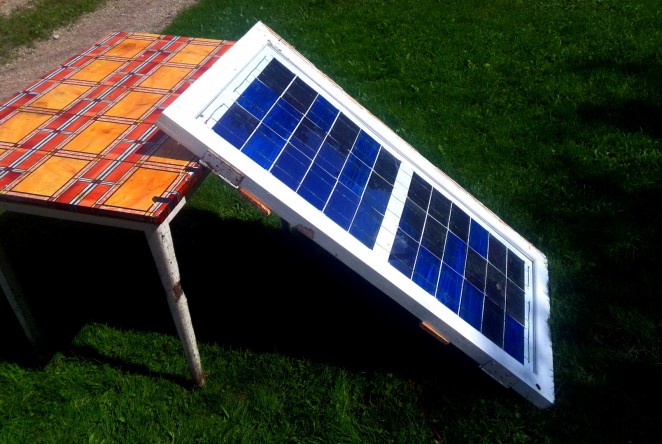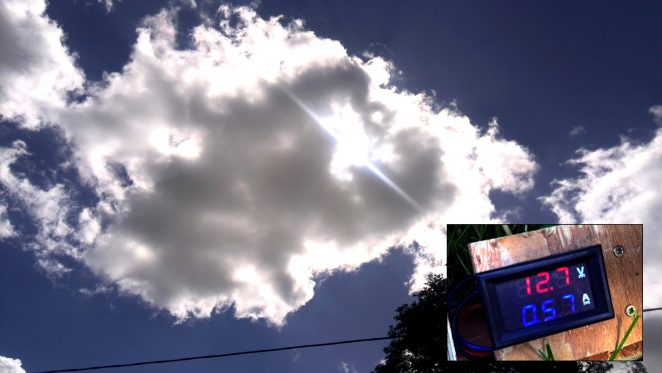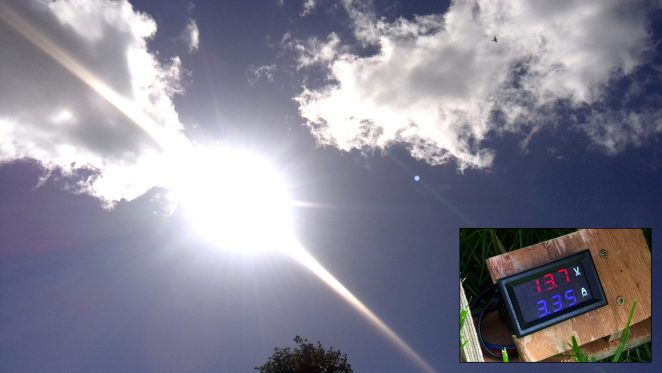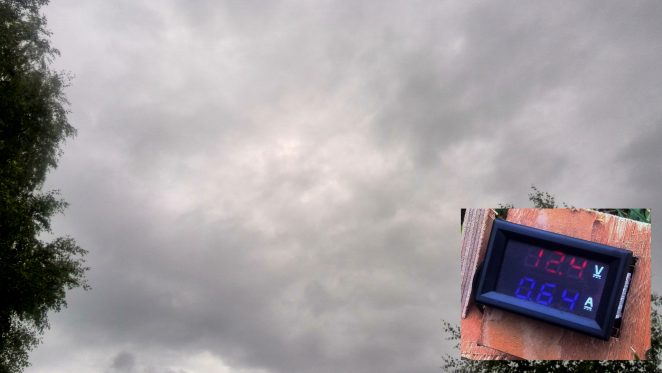
My 65W DIY solar panel testing
Maybe you have also wondered how much power do solar panels generate on a cloudy day compared to the clear sky? Other than the location on earth this is also a huge factor in overall performance.
I had the same questions myself.
So I tested my solar panel. I included my location on earth and time of the day when the test was carried out. For better visualization, I included also photos of the sky when measurements were taken. I also included cloudy sky testing. Not much scientific, but more of an example what can be produced on my latitude. Should probably compare to some online calculator to see how much I am off.
My solar panel and test setup
One year ago I built my first bigger DIY solar panel which should ideally deliver 65W. Today I cleaned it up and hooked up it up with car battery through solar controller cmtp02 and put a volt-ampere meter between controller and panel. There is also post showing how I tabbed solar cells together with self-made jig if interested.
The panel itself is actually not finished yet and very robust build (old window frame with glass). It has 36 cells and each cell should be 1.8W. So overall rating should be 36 cells * 1.8 W = 64.8W (~65W).
Some results measured with my DIY solar panel
Here are the results with photos.
Time and place measurements were taken
- Location: Europe, Estonia, Lat: 58.3216 Lng: 25.7577
- Latitude: 58.323162158° 19′ 23.38” N
- Longitude: 25.762687225° 45′ 45.67” E
- Time of the day: around 14:00 local time
- The date was 8 June for first tests.
With cloud covering
When cloud moved over the sky- readings were following.
- Volts: 12.7
- Amps: 0.57
- Watts: 7.24
As expected, output decreased drastically, but still, this “ambient” light produces some electricity. With one panel in the array, it’s close to nothing.
Clear sky
Nice clean direct sun results. Results are much better.
- Volts: 13.7
- Amps: 3.35
- Watts: 45.9
Rainy, grey clouds, fully cloudy
Another day month later. Almost rainy grey clouds that cover all the sky. Started rain after I made this test. Nice thick clouds covering the sky and the result was almost the same as when a bright day with a cloud covering. Maybe it’s because of the July – I don’t know. But I was still impressed by its efficiency.
- Volts: 12.4
- Amps: 0.64
- Watts: 7.94
How much power do solar panels produce on a cloudy day?
From my solar panel, I saw ~84% decrease in performance on a cloudy day compared to the bright clear sky. In other words, the panel only produced~16% of its maximum power. It’s actually more I expected. It’s still a power I could harvest.
These numbers are also confirmed in here and here. They both agree that it should be 10% to 25%. So my calculations hit the middle mark. A quite accurate drop in power generation.
The conclusion of my solar panel testing
Overall- it produces 20W less power than “rated”. But I am not sure- is charging the battery the right load for this test. Maybe I’ll find something better in future to carry out this testing. But I’m pretty OK with these results also.






Nice looking panel.
Your output is probably just about right considering your location and the ~12 volt load you are asking the panels to drive. You are correct in your assumption that this is not quite optimum for your 36 series connected solar cells. Won’t hurt the solar panel in any way, but you will not quite get the full rated power.
To get the full output, you need a load that operates the solar cells at the “Maximum Power Point” voltage, which is close to 18 volts for a 36 cell panel. There are special switching power supply based converters called MPPT controlers, which are specifically designed to convert from the optimum voltage to 12 volts, so you can actually get the full rated power from your solar panel. It turns out that the optimum voltage changes with temperature and light level, so these MPPT controlers also track and automatically find and set the best voltage conversion ratio for maximum power transfer.
MPPT charge controllers are a bit pricey though, so there is nothing wrong with running the panels into a lower voltage battery directly – but I would add at least a basic charge controller of some sort to cut off charging at full charge, otherwise even 40 watts will quickly overcharge and cook your batteries. You should be able to find (or make) a simple ON/OFF or PWM charge controller suitable for a single panel for only about 15 euros.
I guess 16% in cloud day is good.
What company produces these solar panels?
Hi how did you wore up the volt/a meter to the solar panel? Thanks
Basically like in my other article about volt-ammeters: http://diyprojects.eu/how-to-wire-digital-dual-display-volt-and-ammeter/
On those diagrams the solar panel would be the “Power supply” part and battery would be the “Load” part. But be aware this can be not maximum load since battery could take in less than actual solar panel output would be.